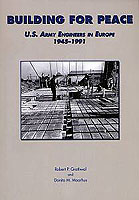U.S. Army in the Cold War Series

BUILDING FOR PEACE: U.S. ARMY ENGINEERS IN EUROPE, 1945-1991
Robert P. Grathwol, Donita M. Moorhus
U.S. Army in the Cold War
CMH Pub 45-1, Cloth; CMH Pub 45-1-1, Paper
2005; 483 pages, illustrations, charts, maps, index
GPO S/N: 008-029-00409-7, Cloth; GPO S/N: 008-029-00410-1, Paper
Building for Peace traces the U.S. Army's engineering construction activities in Europe, beginning immediately after World War II in 1945 and ending with the dissolution of the Soviet Union in 1991. In their fine organizational account that details the twists and turns of the Cold War's history, Robert P. Grathwol and Donita M. Moorhus describe the often less glamorous but nonetheless critical missions of conscientious Army engineers-military officers, civilians, and local-national employees and contractors-who worked tirelessly to prepare the physical infrastructure in Europe, the battleground of what was perceived as the next Armageddon. The U.S. Army Corps of Engineers played a central role in building and maintaining the infrastructure in support of the U.S. and NATO forces that stood on the front lines of the Cold War. Grathwol's and Moorhus's study, covering almost a half-century of military construction in Europe that cost more than $5 billion, serves to record not only the achievements of Army engineers but also their contribution to the legacy of the peaceful triumph of democracy. This story is worth reading and remembering.
* View this publication online.